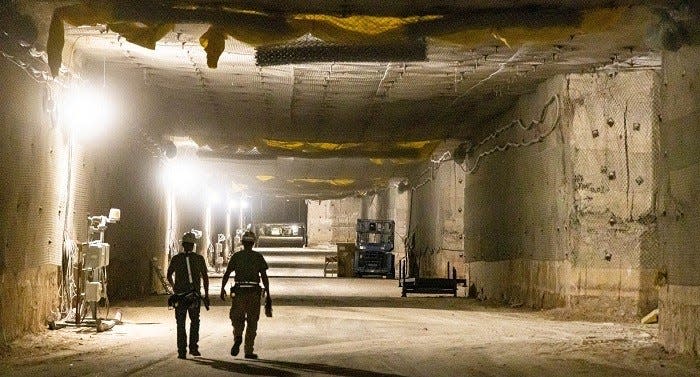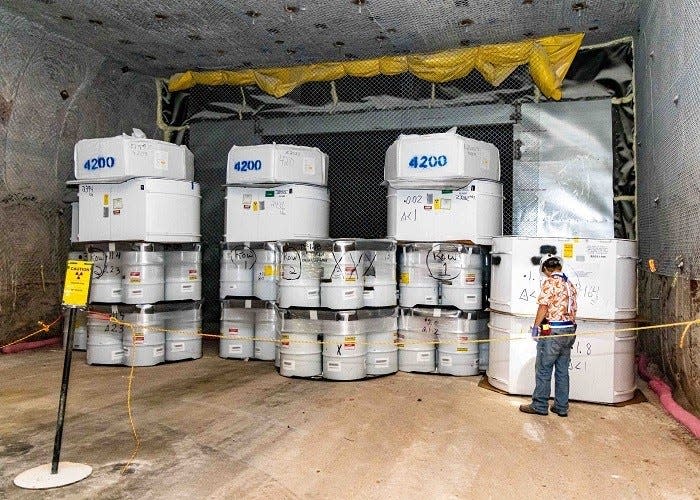Nuclear waste from Tennessee filling new disposal area at repository near Carlsbad
Nuclear waste disposed of in the eighth disposal panel of the Waste Isolation Pilot Plant was initially from Oak Ridge National Laboratory in Tennessee.
The waste, known as transuranic (TRU) nuclear waste was brought to WIPP via truck as with all the waste disposed of at the repository near Carlsbad from Department of Energy sites across the country, and buried in an underground salt deposit about 2,000 feet underground, according to a Nov. 22 announcement.
Panel 8 was mined earlier this year and Panel 7 was filled last month.
More:Gov. Lujan Grisham demands President Biden block nuclear waste site in southeast New Mexico
The new disposal area contained seven rooms where drums of waste are emplaced, each about 33 feet wide, 16 feet high and 300 feet long.
That process meant mining about 160,000 tons of salt.
Panels in the WIPP underground are designed to be filled in about 2.5 years, according to a report from the DOE’s Office of Environmental Management.
More:Transition begins for $3B nuclear waste contract at federal disposal site near Carlsbad
But Panel 7, which was recently filled, began operations in 2013, records show, and work to fill it with TRU waste was delayed almost eight years after a series of incidents at the site.
In 2014, a truck caught fire in the underground near the panel, leading to an evacuation of workers from the repository.
Days later, a mispackaged drum from Los Alamos ruptured and released radioactive material into the area, bringing a three-year shutdown of underground operations, and investigation by the State of New Mexico and a $73 million fine paid to the state by the federal government.

More:Incidents at nuclear waste repository near Carlsbad, COVID-19 disrupt disposal
Since waste emplacement and mining operations resume in 2017, workers were required to wear ventilators and other protective equipment to avoid exposure to radioactivity.
That was not required in Panel 8 as Panel 7 was filled Oct. 21, blocking contamination from the rest of the underground.
About 20,000 waste containers were emplaced in Panel 7 since it began accepting waste, records show.
More:Nuclear waste repository poses risk to New Mexico, critics say during forum in Santa Fe
Panel 8 is also the final disposal area permitted by New Mexico Environment Department, but the DOE sought to add two additional panels via its ongoing permit renewal process to make up for space lost in the 2014 incident.
This additional space would not increase WIPP’s statutory capacity of 6.2 million cubic feet, but serve as “replacement space,” WIPP officials said.
Sean Dunagan, president of Nuclear Waste Partnership – the DOE-hired contractor that operated the WIPP site through the past decade through the 2014 release and its recovery – said the resulting stricter oversight and safety protocols made Panel 8 operations “more efficient.”
More:Legality of nuke waste storage at Texas, New Mexico border questioned during court hearing
Continued work at WIPP could also soon be under increased airflow with the about $400 million rebuild of its ventilation system known as the Safety Significant Confinement Ventilation System (SSCVS), and a $100 million effort to build and install a new air intake shaft.
Together, the shaft and SSCVS were estimated to increase the air available in WIPP’s underground from 170,000 cubic feet per minute (cfm) to 540,000 cfm.
“We have already seen significant increases in our efficiency as we have emplaced in Panel 8 compared to Panel 7,” Dunagan said in a statement. “WIPP has the best workforce of anywhere in the complex, and I am so excited for the team as we make this significant move in Panel 8.”

More:Final nuclear waste disposed of in contaminated area of repository near Carlsbad
Oak Ridge National Laboratory, where the first waste in Panel 8 came from, sent 253 shipments of waste to the WIPP site as of Sept. 3, according to the latest report from the DOE.
That made Oak Ridge the sixth-biggest shipper to WIPP of the 13 sites it accepted waste from since opening in 1999, records show.
The DOE’s Hanford Site in Washington was fifth with 572 shipments, following Los Alamos National Laboratory with 1,545 shipments and Savannah River Site in South Carolina with 1,696 shipments.
More:Federal government eyeing nuclear repository in Carlsbad for new kinds of waste
Idaho National Laboratory (INL) sent 6,716 shipments, the most of any DOE site, following by 2,045 shipments from the now-defunct Rocky Flats Environmental Technology Site near Denver.
Shipments from Idaho recently resumed after a series of incidents involving contaminated waste containers and an inquiry by NMED.
The DOE’s Carlsbad Field Office (CBFO) responded to NMED’s request for information, according to the latest report from the Defense Nuclear Facilities Safety Board issued Nov. 4, and WIPP resumed shipments from the lab.
“After CBFO responded to an NMED letter regarding the shipments, providing the information requested by NMED, WIPP resumed receipt of shipments from INL,” read the report.
The Board also reported issued with air monitors at the site, after two continuous air monitors (CAMS) in the waste handling area on the surface alerted for possible contamination.
NWP ultimately found no radiological contamination, the report read, attributing the alerts to radon gas at the facility.
“The results of the tests indicated that there was no radiological contamination. NWP concluded that the alarms were triggered by radon,” read the report. “WIPP senior management is evaluating the implications of these types of nuisance alarms.”
Adrian Hedden can be reached at 575-628-5516, achedden@currentargus.com or @AdrianHedden on Twitter.
This article originally appeared on Carlsbad Current-Argus: Tennessee nuclear waste filling disposal area at site near Carlsbad

